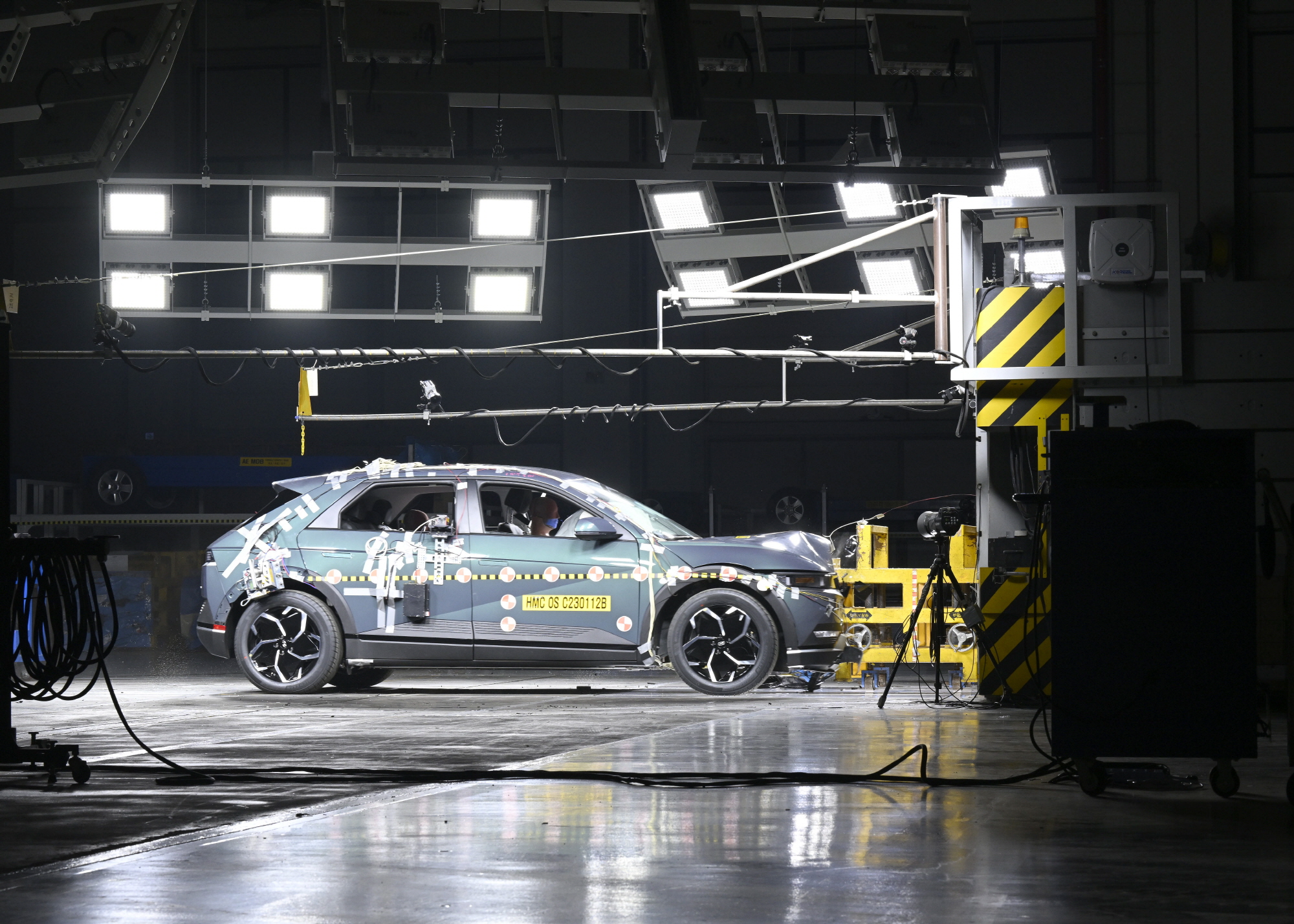
The sound announcing the start of the crash test echoes. With an impressive roar, the Ioniq 5 rushes towards a massive wall, crashing into it with a deafening sound as it comes to a halt. The front end of the vehicle is shattered, but the dummies inside remain intact. This is a moment that once again confirms the safety of the Hyundai Ioniq 5.
On the 12th, Hyundai conducted a crash test of the Ioniq 5 at the Hyundai Kia Namyang Research and Development Center in Hwaseong, Gyeonggi-do. The R&D building, which spans 12,100 pyeong, was completed in 2005 and conducts crash tests for all passenger and SUV models released domestically and internationally. Various adult male sizes, along with dummies representing women and children, sit neatly in rows.
Passing through the area where the dummies are seated, I entered the crash test facility where a massive wall stood. The crash test area measures 877 pyeong and is divided into three tracks, allowing for head-on, rear, small overlap, car-to-car, and side collisions. Executive Baek Chang-in of the R&D division emphasized the busy day-to-day operations, stating, “We conduct over 650 crash tests annually at speeds of up to 100 km/h.”
For the test, THOR dummies in adult male and female sizes were placed in the driver’s seat and backseat, respectively. The THOR dummy features 157 sensors attached throughout, which can provide data on various injuries sustained during a collision, including concussions.
Before the crash test, Executive Baek highlighted that 26 models from the company received Top Safety Pick and Top Safety Pick+ from the Highway Safety Insurance Institute. He noted, “We ranked second with 26 models, just one less than Volkswagen’s 27 models and significantly ahead of Toyota’s 20 models, which was in third place.”
Baek also emphasized the safety of the E-GMP platform used by the Ioniq 5. He stated, “The E-GMP platform does not sustain battery damage during various collisions. We test it to the limits of the battery module.” Furthermore, he revealed that in addition to real-world crash tests, they perform virtual crash tests via computer for further verification, showcasing great pride in the extensive validation of their real-world tests.
After all announcements, the defining moment arrived. The host announced, “We will conduct the test at 64 km/h under a 40% offset condition.” A 64 km/h crash with a 40% offset is a critical crash test condition mandated by the Highway Safety Insurance Institute of the United States.
For safety, barriers were installed, and a loud warning sound signaled the beginning of the crash test. At that moment, the hearts of onlookers began to race. Suddenly, amidst the deafening noise, the Ioniq 5 charged towards the wall like a raging bull. In a thunderous crash, the Ioniq 5 slammed into the test wall, accompanied by the explosive sounds of airbags deploying; the noise of the impact was staggering, even for those wearing earmuffs.
We were given the opportunity to closely examine the damaged vehicle after the crash. In the 40% offset collision, the front left fender of the vehicle was completely crumpled, but the cabin was unscathed.
This was thanks to the crumple zone designed for shock absorption. While the impact area crumpled, the cabin maintained a safe environment for the passengers. Without the crumple zone technology, the shock from a collision would directly affect the passenger compartment, creating a dangerous scenario where it too could become a crumpled heap.
Thanks to the crumple zone technology used in the Ioniq 5, only the fender area was crumpled, while the A-pillar retained its original shape. Furthermore, the airbags on the side where the dummies were seated deployed perfectly.
The Hyundai Research Institute stated, “There were no issues with the door’s opening after the crash test. The collision speed was 64.1 km/h, and the impact location range was maintained within 1% accuracy,” conveying the results of the experiment. They also emphasized their confidence in the safety of the E-GMP platform, saying, “All measurements of high-voltage insulation resistance were normal, and there were no leaks or fires from electrolyte leakage due to high-voltage battery failures.”
Lee Sang-jin daedusj@autodiary.kr
